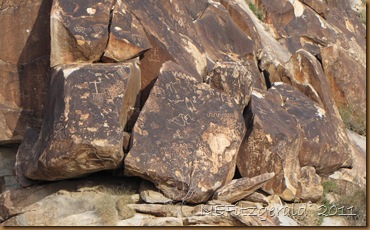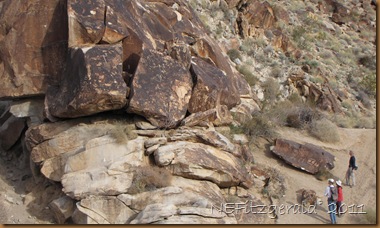The final hike of our four-day winter getaway–hiking extravaganza in the Laughlin NV area was in Grapevine Canyon. For the first time this weekend, I even had an idea where we were going!
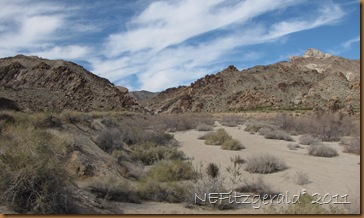 |
| Grapevine Canyon |
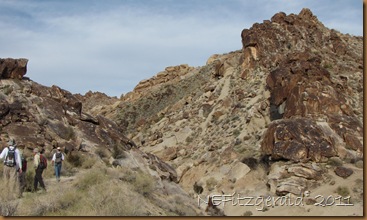 |
| Grapevine Canyon and main area of petroglyphs |
Located in the Newberry Mountains/Spirit Mountain/Christmas Tree Pass area of Lake Mead National Recreation Area, Grapevine Canyon is well known for its rock art. Very large abstract designs dominate the site. According to the NPS website archaeological evidence of canyon rock shelters indicates that ancestors of modern Mojave people and perhaps Southern Paiute people camped here for a few days at a time as early as 1100 AD; use continued also into modern times.
Many petroglyphs are created by chipping through a dark coat of “desert varnish” to expose an underlying lighter colored rock. Desert varnish is a prominent feature commonly seen coating many rock surfaces in arid regions such as the desert southwest. Another term is “rock varnish” which applies to dark coatings on rocks in general. You can also see desert varnish streaking canyon walls where water has flowed down the walls.

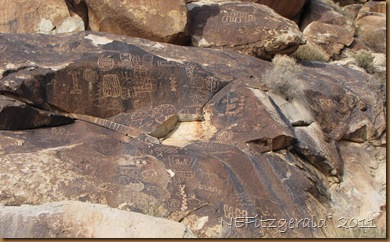
Questions often arise as to why these petroglyph designs and figures were carved into the rock. Why are they here? Who carved them? What do they mean?
My own questions, however, are different. They are not archaeological but geological. What, really, is desert varnish? How does it form?
Over the years I learned (somewhere) that desert varnish is a coating of red iron oxide and black manganese oxide along with bacteria. The bacteria living on the rock absorb manganese and iron from the rock itself and excrete it as a thin layer of black manganese oxide or reddish iron oxide onto the rock surfaces (a biochemical change). This thin layer also helps protect the bacteria from drying out or decaying.
Or so I thought.
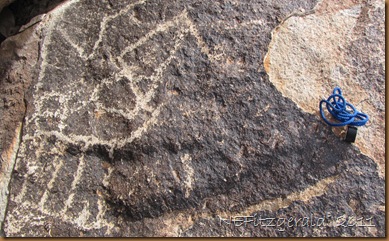 |
| Close-up of petroglyphs on desert or rock varnish |
Interestingly, my Glossary of Geology gives a somewhat different definition of desert or rock varnish that is not really biological: It is a thin dark shiny film or coating composed of iron oxide [with] traces of organic matter, manganese oxide, and silica… It is believed to be caused by exudation [or oozing] of mineralized solutions from within [the rock] and deposition by evaporation on the surface.
Hmmmm… There seems to be some discrepancy here.
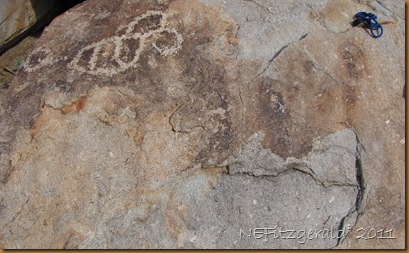 |
| Close-up of petroglyphs on desert or rock varnish |
Apparently, however, the coating of desert varnish is composed mainly of clay minerals. The black manganese oxides and red iron oxides are contained within the clays which are cemented. These clays are found locally where the varnish develops and appear to be derived from airborne dust.
But how far does this airborne dust travel? From southern Idaho? Ontario? Siberia? The rocks at Grapevine Canyon on which the petroglyphs are carved looked granitic. It makes sense, then, that any feldspar minerals making up this granite would be one source of the clays, since feldspars eventually break down to quartz and clays. Perhaps mainly local winds are the reason the clays are airborne, blown around in dust devils and dry desert windstorms.
BTW: I neglected to mention in my last post that I was three-for-three with my on-the-fly field identification skills of yet another lithic tuff. Now I’m four-for-four with varnish and granite and I’ve stopped keeping score.
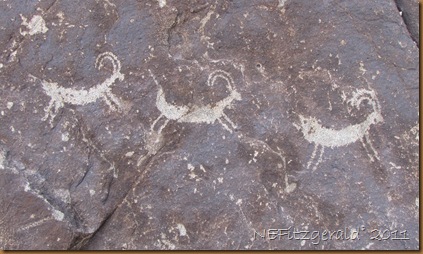
For desert varnish see: http://minerals.caltech.edu/files/varnish/index.html

